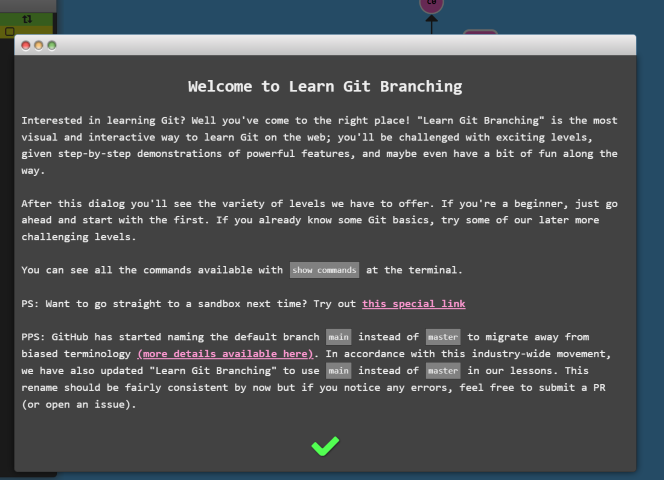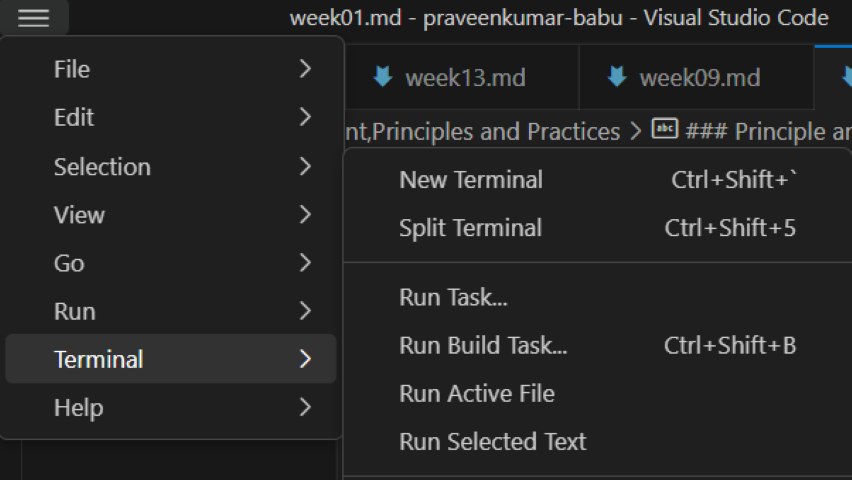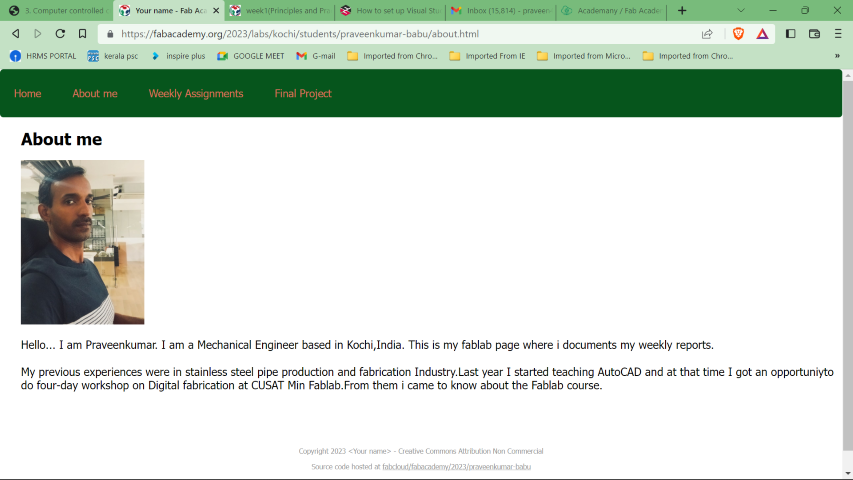1. Project Management,Principles and Practices
# 1. Project Management,Principles and Practices
assignment work through a git tutorial build a personal site in the class archive describing you and your final project
Project Management¶
I havé currnetly two ideas for my fabacedemy final project.
-
First one is Vertival axis wind turbine .
-
Second is Duel axis solar tracking
Vertival axis wind turbine¶
The main rotor shaft of a vertical axis wind turbine (VAWT) is positioned vertically and perpendicular to the ground. In horizontal axis wind turbine (HAWT) main rotor shaf is parallel to the ground.
The following are some essential qualities of vertical axis wind turbines:
Design: The primary vertical rotor shaft of VAWTs is surrounded by blades.
VAWTs are omnidirectional, which allows them to collect wind from all directions.
VAWTs can be deployed at lower heights and are frequently less in size than HAWTs.
Performance at low wind speeds and during startup are two characteristics of VAWTs that set them apart from HAWTs.
In comparison to HAWTs, VAWTs typically produce less noise and less vibration.
Compared to HAWTs, VAWTs typically have a simpler design with fewer moving parts,hence Lower maintenance.
Efficiency and power output: When compared to HAWTs, VAWTs typically have lesser efficiency and power production.
Applications: VAWTs are frequently employed in small-scale or decentralised settings, including homes, businesses, cities, and places that are off the grid.

Dual axis solar tracking¶
A dual-axis solar tracker system is a technology used to maximize the amount of solar energy collected by solar panels by continuously adjusting their position to face the sun directly. Unlike fixed solar panel systems, which are set in one position, dual-axis solar tracker systems track the sun’s position throughout the day to capture maximum sunlight.
The system typically consists of a solar panel mounted on a frame that is connected to two motorized axes: the azimuth axis, which rotates the panel horizontally, and the elevation axis, which tilts the panel vertically. These motors are controlled by a tracking algorithm that determines the position of the sun and calculates the optimal angle and direction for the solar panel to face.
Dual-axis solar tracker systems can significantly increase the energy output of a solar panel by up to 40% compared to fixed solar panels. However, they are typically more expensive and require more maintenance than fixed solar panels.
Overall, dual-axis solar tracker systems are an effective way to maximize solar energy collection and can be a worthwhile investment in situations where space is limited, and the cost of electricity is high.

Principle and practices¶
Version Control¶
Version control is a system that manages and tracks changes made to files over time. It is commonly used in software development and other collaborative projects where multiple people are working on the same set of files. The purpose of version control is to keep a record of all changes, facilitate collaboration, and enable easy retrieval of previous versions of files.
Version control systems can be divided into two categories:
Centralised Version Control Systems (CVCS): In a CVCS, all file versions are kept in a single central repository. Files from the repository are checked out by developers or team members, who subsequently modify the files and commit the modifications to the repository. Perforce and Subversion (SVN) are two examples of CVCS.
DVCSs (Distributed Version Control Systems): In a DVCS, every user has a full copy of the repository, including the whole history of changes. Users are free to work alone, making modifications that are then committed to a local repository. By pushing or pulling modifications to and from distant repositories, they can also share their changes with others. DVCS systems like Git, Mercurial, and Bazaar are examples.
Git, which is a distributed version control system, has gained significant popularity in recent years and is widely used in software development. It offers a rich set of features, including efficient branching and merging, support for both local and remote repositories, and extensive community support.
Overall, version control systems provide a structured and efficient way to manage changes and collaborate on projects, ensuring that files are properly tracked, organized, and protected throughout their lifecycle.
The following tutorials from gitlab covers most of the fundamentals about git. gitlab tutorial
Setting up GitHub with Visual Studio¶
VS installed sucessfully

Downloading git¶
Welcome to Learn Git Branching “Learn Git Branching” is the most visual and interactive way to learn Git on the web; you’ll be challenged with exciting levels, given step-by-step demonstrations of powerful features, and maybe even have a bit of fun along the way.

Install Git follow the below link download git and follow the setup sequence
 Installing git
Installing git

After installing git we need to see that it is running for that got to VS code and clivk terminal then hit new terminal
 Inside the new terminal type the command git–version
Inside the new terminal type the command git–version

My git version installed is 2.39.1
Installing git locally and adding SSH key
 In gitlab Web go to user setting -SSH key.
In gitlab Web go to user setting -SSH key.
To generate SSH key my PC I followed this in gitlab tutorial


pasting key in SSH

Launched gitlab
 SSH URL copied from git and paste it in gitbash for clonning
SSH URL copied from git and paste it in gitbash for clonning
 Clonned successfully
Clonned successfully
Commit and push in VS Code¶
In Visual Studio (VS) Code, “commit” and “push” are actions commonly performed when using version control systems like Git. Here’s how you can perform these actions in VS Code:
Initialize a Git repository: Before you can commit and push changes, you need to initialize a Git repository in your project folder. You can do this by opening the project folder in VS Code and using the integrated terminal or by running the following command in the terminal: ‘git init’.
Stage your changes: After making modifications to your files, you need to stage the changes before committing them. In VS Code, you can do this in several ways:
Using the Source Control view: Open the Source Control view by clicking on the Git icon in the sidebar (or by using the shortcut ‘Ctrl+Shift+G’ or ‘Cmd+Shift+G’). You’ll see a list of modified files. Click the “+” button next to each file you want to stage, or use the “+” button in the header to stage all changes.
Using the command palette: Press ‘Ctrl+Shift+P’ (or ‘Cmd+Shift+P’ on macOS) to open the command palette and search for “Git: Stage All Changes” or “Git: Stage Changes” to stage the changes.
Commit your changes: Once your changes are staged, you can commit them with a meaningful message to describe the changes. In the Source Control view, you’ll see an input box where you can enter the commit message. Alternatively, you can use the command palette and search for “Git: Commit” or “Git: Commit All” to open the commit message input box.
Push your changes: After committing your changes, you can push them to a remote repository, such as GitHub or GitLab. To push your changes, use one of the following methods:
Using the Sync button in the bottom-left corner of the VS Code window (if it’s enabled). Click the icon and select “Push” from the dropdown menu.
Using the command palette: Open the command palette and search for “Git: Push” to push your changes.
Using the integrated terminal: You can also push your changes by running the command ‘git push’ in the terminal.
Building a website¶
Web designing using Visual studio .
Visual Studio is primarily an integrated development environment (IDE) for software development, but it also supports web development. If you want to design a website using Visual Studio, you can use the following features and tools:
HTML, CSS, and JavaScript: Visual Studio provides code editing and syntax highlighting for HTML, CSS, and JavaScript, the core languages used in web development. You can create and edit HTML pages, CSS stylesheets, and JavaScript files using the built-in code editor.
adding my image in web page

Designing my Web page






